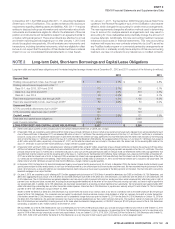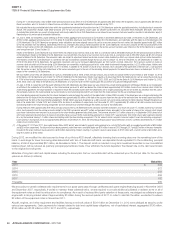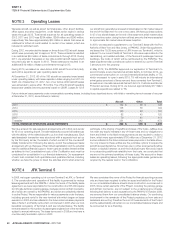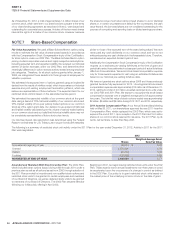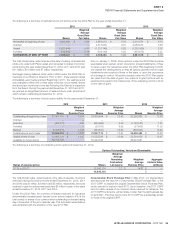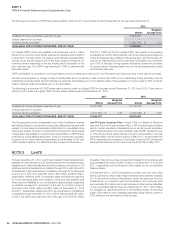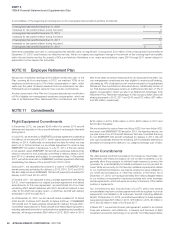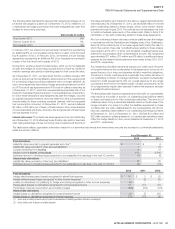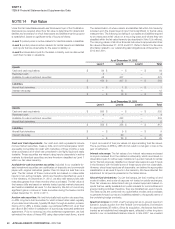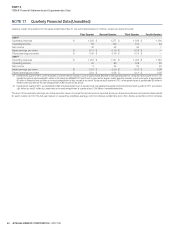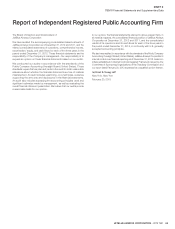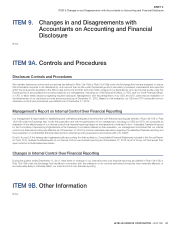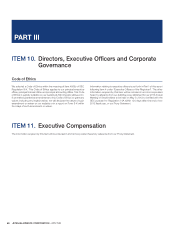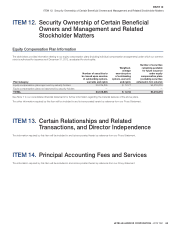JetBlue Airlines 2012 Annual Report Download - page 63
Download and view the complete annual report
Please find page 63 of the 2012 JetBlue Airlines annual report below. You can navigate through the pages in the report by either clicking on the pages listed below, or by using the keyword search tool below to find specific information within the annual report.
JETBLUE AIRWAYS CORPORATION-2012 10K 59
PART II
ITEM 8Financial Statements and Supplementary Data
under this agreement include a minimum of $9 million through 2018 and
an additional $23 million for minimum hardware and software purchases.
Through LiveTV, we plan to partner with ViaSat to make this technology
available to other airline customers in the future as well.
We enter into individual employment agreements with each of our FAA-
licensed employees, which include pilots, dispatchers, technicians and
inspectors as well as air traffi c controllers. Each employment agreement
is for a term of fi ve years and automatically renews for an additional fi ve-
year term unless either the employee or we elect not to renew it by giving
at least 90 days notice before the end of the relevant term. Pursuant to
these agreements, these employees can only be terminated for cause.
In the event of a downturn in our business that would require a reduction
in work hours, we are obligated to pay these employees a guaranteed
level of income and to continue their benefi ts if they do not obtain other
aviation employment. None of our employees are covered by collective
bargaining agreements.
NOTE 12 Contingencies
We self-insure a portion of our losses from claims related to workers’
compensation, environmental issues, property damage, medical insurance
for employees and general liability. Losses are accrued based on an
estimate of the ultimate aggregate liability for claims incurred, using
standard industry practices and our actual experience.
We are a party to many routine contracts under which we indemnify third
parties for various risks. These indemnities consist of the following:
All of our bank loans, including our aircraft and engine mortgages, contain
standard provisions present in loans of this type which obligate us to
reimburse the bank for any increased costs associated with continuing
to hold the loan on our books which arise as a result of broadly defi ned
regulatory changes, including changes in reserve requirements and bank
capital requirements. These indemnities would have the practical effect
of increasing the interest rate on our debt if they were to be triggered.
In all cases, we have the right to repay the loan and avoid the increased
costs. The term of these indemnities matches the length of the related
loan up to 12 years.
Under both aircraft leases with foreign lessors and aircraft and engine
mortgages with foreign lenders, we have agreed to customary indemnities
concerning withholding tax law changes under which we are responsible,
should withholding taxes be imposed, for paying such amount of additional
rent or interest as is necessary to ensure that the lessor or lender still
receives, after taxes, the rent stipulated in the lease or the interest stipulated
under the loan. The term of these indemnities matches the length of the
related lease up to 18 years.
We have various leases with respect to real property, and various agreements
among airlines relating to fuel consortia or fuel farms at airports, under
which we have agreed to standard language indemnifying the lessor
against environmental liabilities associated with the real property or
operations described under the agreement, even if we are not the party
responsible for the initial event that caused the environmental damage.
In the case of fuel consortia at airports, these indemnities are generally
joint and several among the participating airlines. We have purchased a
stand alone environmental liability insurance policy to help mitigate this
exposure. Our existing aviation hull and liability policy includes some limited
environmental coverage when a clean up is part of an associated single
identifi able covered loss.
Under certain contracts, we indemnify specifi ed parties against legal liability
arising out of actions by other parties. The terms of these contracts range
up to 30 years. Generally, we have liability insurance protecting ourselves
for the obligations we have undertaken relative to these indemnities.
LiveTV provides product warranties to third party airlines to which it
sells its products and services. We do not accrue a liability for product
warranties upon sale of the hardware since revenue is recognized over
the term of the related service agreements of up to 12 years. Expenses
for warranty repairs are recognized as they occur. In addition, LiveTV has
provided indemnities against any claims which may be brought against its
customers related to allegations of patent, trademark, copyright or license
infringement as a result of the use of the LiveTV system. LiveTV customers
include other airlines, which may be susceptible to the inherent risks of
operating in the airline industry and/or economic downturns, which may
in turn have a negative impact on our business.
Under certain of our LiveTV third party agreements, as well as certain
of our operating lease agreements, we are required to restore certain
property or equipment to its original form upon expiration of the related
agreement. We have recorded the estimated fair value of these retirement
obligations of approximately $9 million as of December31, 2012. This
liability may increase over time.
We are unable to estimate the potential amount of future payments under
the foregoing indemnities and agreements.
Environmental Liability
Many aspects of airlines’ operations are subject to increasingly stringent
federal, state, local, and foreign laws protecting the environment. There
is growing consensus that some form of regulation will be forthcoming
at the federal level with respect to greenhouse gas emissions (including
carbon dioxide (CO2)) and such regulation could result in the creation of
substantial additional costs in the form of taxes or emission allowances.
Since the domestic airline industry is increasingly price sensitive, we may
not be able to recover the cost of compliance with new or more stringent
environmental laws and regulations from our passengers, which could
adversely affect our business. Although it is not expected that the costs
of complying with current environmental regulations will have a material
adverse effect on our fi nancial position, results of operations or cash fl ows,
no assurance can be made that the costs of complying with environmental
regulations in the future will not have such an effect. The impact to us
and our industry from such actions is likely to be adverse and could be
signifi cant, particularly if regulators were to conclude that emissions from
commercial aircraft cause signifi cant harm to the upper atmosphere or
have a greater impact on climate change than other industries.
In 2012, during performance of environmental testing required in connection
with the demolition of the passenger terminal buildings and closure of the
defunct hydrant fuel systems on the Terminal 6 site at New York’s John F.
Kennedy International Airport, or JFK, the presence of light non-aqueous
phase petroleum liquid was discovered in certain subsurface monitoring
wells on the property. Our lease with the Port Authority of New York and New
Jersey, or PANYNJ, provides that, under certain circumstances, we may be
responsible for investigating, delineating, and remediating such subsurface
contamination, even if we are not necessarily the party that caused its
release. We have engaged environmental consultants and legal counsel to
assess the extent of the contamination and assist us in determining whether
we are responsible for taking steps to remediate it. A preliminary estimate
indicates costs of remediation could range from less than $1 million up
to approximately $3 million. As of December 31, 2012, we have accrued
$2 million for current estimates of remediation costs, which is included in
current liabilities on our consolidated balance sheets. However, as with any
environmental contamination, there is the possibility this contamination could
be more extensive than estimated at this early stage.
Based upon information currently known to us, we do not expect these
environmental proceedings to have a material adverse effect on our


